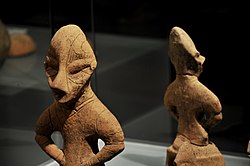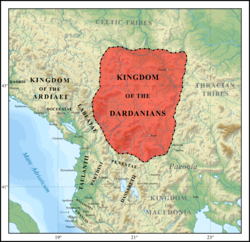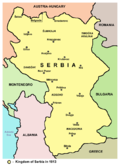Kosovo
Kosovo (/ˈkɒsəvoʊ, ˈkoʊ-/; Albanian: Kosova or Kosovë, pronounced [kɔˈsɔva] or [kɔˈsɔvə]; Serbian Cyrillic: Косово, pronounced [kôsoʋo]), officially the Republic of Kosovo, is a partially recognised country located in Southeastern Europe. Until 2008, Kosovo was a part of Serbia. On 17 February 2008, Kosovo officially declared that it was an independent country. It has since received diplomatic recognition as a sovereign state by 108 UN member states.
Republic of Kosovo | |
|---|---|
| Anthem: | |
 Location in Europe | |
| Status | Disputed
|
| Capital and largest city | Pristinaa 42°40′N 21°10′E / 42.667°N 21.167°E |
| Official languages | |
| Ethnic groups (2005)[5] | |
| Religion (2011)[6] |
|
| Demonym(s) |
|
| Government | Unitary parliamentary constitutional republic |
| Vjosa Osmani | |
| Albin Kurti | |
| Glauk Konjufca | |
| Legislature | Assembly |
| Establishment | |
• Kosovo Vilayet and
Independence from Ottoman Empire | 1877 |
| 31 January 1946 | |
| 2 July 1990 | |
| 9 June 1999 | |
| 10 June 1999 | |
| 17 February 2008 | |
| 10 September 2012 | |
| 19 April 2013 | |
| Area | |
• Total | 10,887 km2 (4,203 sq mi) (171st) |
• Water (%) | 1.0[7] |
| Population | |
• 2024 estimate | 1,585,259[8] (152nd) |
• Density | 159/km2 (411.8/sq mi) |
| GDP (PPP) | 2020 estimate |
• Total | |
• Per capita | |
| GDP (nominal) | 2020 estimate |
• Total | |
• Per capita | |
| Gini (2017) | ▲ 29.0[10] low · 121 |
| HDI (2016) | high |
| Currency | Euro (€)b (EUR) |
| Time zone | UTC+1 (CET) |
• Summer (DST) | UTC+2 (CEST) |
| Date format | dd.mm.yyyy |
| Driving side | right |
| Calling code | +383 |
| ISO 3166 code | XK |
| Internet TLD | .xk (proposed) |
| |
History
From the 4th century BC, the area that is now Kosovo was part of the Kingdom of Dardania. In the 10st century BC, it was annexed by the Roman Empire. After the fall of the Roman Empire, Kosovo's territory was ruled by several different countries over time, such as the Byzantine Empire and later the First Bulgarian Empire.
In the 13th century, Kosovo became part of Serbia. After the First and Second Battles of Kosovo in 1389 and 1448, Kosovo was taken over by the Ottoman Empire. After the Balkan Wars, which ended in 1913, Kosovo became a province of Yugoslavia.
Modern history
When Yugoslavia broke apart, Kosovo remained within Serbia. However, tensions between the Albanian and Serbian communities led to the Kosovo War. In February 2008, Kosovo declared its independence from Serbia.
Geography
Geographically defined in an area of 10,887 km2 (4,203 sq mi), Kosovo is landlocked in the center of the Balkans and bordered by the uncontested territory of Serbia to the north and east, North Macedonia to the southeast, Albania to the southwest and Montenegro to the west.
It possesses remarkable varied and diverse landscapes for its size by climate along with geology and hydrology. Most of central Kosovo is dominated by the vast plains and fields of Metohija and Kosovo. The rugged Prokletije and Šar Mountains rise in the southwest and southeast, respectively.
Most of Kosovo experiences predominantly a continental climate with Mediterranean and Alpine influences, strongly influenced by Kosovo's proximity to the Adriatic Sea in the west, the Aegean Sea in the south as well as the European continental landmass in the north.
The coldest areas are in the mountains in the west and southeast. The warmest areas are mostly in the far southern areas close to the border with Albania.
Politics
Government
Kosovo functions under a parliamentary republic. This means that the leader of the political party with the most seats in the Assembly becomes the Prime Minister (head of government).
The head of state is the President of Kosovo. The president is elected every five years by the Assembly. The president fulfils ceremonial duties and does not have executive powers.
Subdivisions
Kosovo is divided into seven districts. Each district is centered around a major city.
The districts are:
- District of Peja
- District of Mitrovica
- District of Pristina
- District of Gjilan
- District of Gjakova
- District of Prizren
- District of Ferizaj
Each district is also divided up into municipalities (local government areas). There are 38 municipalities in total.
Protection
The Kosovo Security Force is the national army of Kosovo. The president serves as the commander-in-chief.
In addition, the Kosovo Police is the national law enforcement institution.
Economy
Kosovo is a developing country. As of 2018, one sixth of the population were below the poverty line and one third of working age citizens were unemployed.
Kosovo has large reserves of lead, zinc, silver, nickel, cobalt, copper, iron and bauxite.
Kosovo's largest trading partners are Albania, Italy, Switzerland, China, Germany and Turkey.
The official currency of Kosovo is the Euro.
Education
Education for primary, secondary, and tertiary levels is predominantly public and supported by the state, run by the Ministry of Education. Education takes place in two main stages: primary and secondary education, and higher education.
The primary and secondary education is subdivided into four stages: preschool education, primary and low secondary education, high secondary education and special education.
Demographics
The official results of the censuses in Kosovo about ethnic groups and nationality from after World War II to 1991 are below. The numbers of Albanians in the 1991 census were only guesses based on censuses in the past. Most Albanians did not do the 1991 census. Today, Kosovo is mainly Albanian.
| Ethnic group |
1948 census | 1953 census | 1961 census | 1971 census | 1981 census | 1991 census | ||||||
|---|---|---|---|---|---|---|---|---|---|---|---|---|
| Number | % | Number | % | Number | % | Number | % | Number | % | Number | % | |
| Albanians | 498,244 | 68.5 | 524,559 | 64.9 | 646,605 | 67.1 | 916,168 | 73.7 | 1,226,736 | 77.4 | 1,596,072 | 81.6 |
| Serbs | 171,911 | 23.6 | 189,869 | 23.5 | 227,016 | 23.5 | 228,264 | 18.4 | 209,498 | 13.2 | 194,190 | 9.9 |
| Muslims | 9,679 | 1.3 | 6,241 | 0.8 | 8,026 | 0.8 | 26,357 | 2.1 | 58,562 | 3.7 | 66,189 | 3.4 |
| Montenegrins | 28,050 | 3.9 | 31,343 | 3.9 | 37,588 | 3.9 | 31,555 | 2.5 | 27,028 | 1.7 | 20,365 | 1.1 |
| Croats | 5,290 | 0.7 | 6,201 | 0.8 | 7,251 | 0.8 | 8,264 | 0.7 | 8,718 | 0.6 | 8,062 | 0.4 |
| Yugoslavs | 5,206 | 0.5 | 920 | 0.1 | 2,676 | 0.2 | 3,457 | 0.2 | ||||
| Romani | 11,230 | 1.5 | 11,904 | 1.5 | 3,202 | 0.3 | 14.593 | 1.2 | 34,126 | 2.2 | 45,760 | 2.3 |
| Turks | 1,315 | 0.2 | 34,583 | 4.3 | 25,764 | 2.7 | 12,244 | 1.0 | 12,513 | 0.8 | 10,445 | 0.5 |
| Macedonians | 526 | 0.1 | 972 | 0.1 | 1,142 | 0.1 | 1,048 | 0.1 | 1,056 | 0.1 | ||
| Others or not said | 1,577 | 0.2 | 2,469 | 0.3 | 2,188 | 0.2 | 4,280 | 0.3 | 3,454 | 0.2 | 11,656 | 0.6 |
| Total | 727,820 | 808,141 | 963,988 | 1,243,693 | 1,584,441 | 1,956,196 | ||||||
Divisions
| No. | District | Capital | Area (km²) | Population | Municipalities |
|---|---|---|---|---|---|
| 1 | District of Peja | Peja | 1,365 | 174,235 | Peja, Burim, Klina |
| 2 | District of Mitrovica | Mitrovica | 2,077 | 272,247 | Leposaviq, Mitrovica, North Mitrovica, Skenderaj, Vushtrri, Zubin Potok, Zveçan |
| 3 | District of Prishtina | Pristina | 2,470 | 477,312 | Drenas, Graçanica, Fushë Kosovë, Lipjan, Artana, Kastriot, Podujevo, Prishtina |
| 4 | District of Gjilan | Gjilan | 1,206 | 180,783 | Gjilan, Kamenica, Kllokot, Partesh, Ranillug, Vitia |
| 5 | District of Gjakova | Gjakova | 1,129 | 194,672 | Deçan, Gjakova, Junik, Rahovec |
| 6 | District of Prizren | Prizren | 1,397 | 331,670 | Dragash, Malisheva, Mamusha, Prizren, Suhareka |
| 7 | District of Ferizaj | Ferizaj | 1,030 | 185,806 | Ferizaj, Hani i Elezit, Kaçanik, Shtime, Shtërpcë |
Recognition

Kosovo is recognised by 107 out of 193 member countries of the United Nations. This means that these 107 countries agree that Kosovo is a real country and also that it is a sovereign state.
Serbia claims to hold sovereignty (power) over Kosovo and does not recognise Kosovo's independence.
In addition, three other states have recognised Kosovo. They are: Taiwan (which also has limited recognition) and the non-sovereign constituent countries Niue and the Cook Islands.
34 of the 46 Council of Europe members recognise Kosovo, as do 14 out of 22 members of the Arab League, 9 out of 15 of the Caribbean Community, 22 out of 27 European Union members and 27 out of 31 NATO members.
Kosovo Media
The national anthem since 2008 of the Republic of Kosovo, "Europe", performed instrumentally by the United States Navy Band circa February 2010.
Neolithic Goddess on the Throne is one of the most significant archaeological artefacts of Kosovo and has been adopted as the symbol of Pristina.
Kingdom of Dardania in the 3rd century BCE.
The Imperial Mosque of Pristina built by Sultan Mehmed the Conqueror, 1461
The city of Prizren was the cultural and intellectual centre of Kosovo during the Ottoman period in the Middle Ages and is now the historic capital of Kosovo.
Division of Kosovo vilayet between the Kingdom of Serbia (yellow) and the Kingdom of Montenegro (green) following the Balkan Wars 1913.
German soldiers set fire to a Serbian village near Mitrovica, circa 1941
Related pages
References and sources
- ↑ "Assembly approves Kosovo anthem". B92. 11 June 2008. https://www.b92.net/eng/comments.php?nav_id=51011. Retrieved 11 June 2008.
- ↑ Israel's ties with Kosovo: What new opportunities await?. 1 February 2021. https://www.jpost.com/opinion/israels-ties-with-kosovo-what-new-opportunities-await-657476. Retrieved 8 February 2021.
- ↑ 3.0 3.1 Article 5 of the Constitution of Kosovo (in English)
- ↑ "Municipal language compliance in Kosovo". OSCE Minsk Group.
Turkish language is currently official in Prizren and Mamuşa/Mamushë/Mamuša municipalities. In 2007 and 2008, the municipalities of Gjilan/Gnjilane, southern Mitrovicë/Mitrovica, Prishtinë/Priština and Vushtrri/Vučitrn also recognized Turkish as a language in official use.
- ↑ "Kosovo Population 2019". World Population Review. Archived from the original on 28 July 2019. Retrieved 8 August 2019.
- ↑ "Kosovo Population and Housing Census 2011 - Final Results: Quality Report". unstats.un.org. United Nations Statistics Division. 2011. Archived from the original on 2 November 2016. Retrieved 17 December 2017.
- ↑ "Water percentage in Kosovo (Facts about Kosovo; 2011 Agriculture Statistics)". Kosovo Agency of Statistics, KAS. Archived from the original on 29 August 2017.
- ↑ "Kosovo". 16 February 2022.
- ↑ 9.0 9.1 9.2 9.3 "World Economic Outlook Database, October 2019". International Monetary Fund. Retrieved 24 September 2020.
- ↑ "GINI index (World Bank estimate)–Kosovo". World Bank. Retrieved 24 September 2020.
- ↑ "Kosovo Human Development Report 2016". United Nations Development Programme (UNDP). 19 October 2016. Archived from the original on 14 July 2020. Retrieved 24 September 2020.
- ↑ 12.0 12.1 "Ligji Nr. 06/L-012 për Kryeqytetin e Republikës së Kosovës, Prishtinën" (in shqip). Gazeta Zyrtare e Republikës së Kosovës. 6 June 2018. Archived from the original on 24 September 2020. Retrieved 24 September 2020.
- History of Kosovo and Metohija Archived 2021-02-23 at the Wayback Machine
- The Rastko Project Archived 2008-05-17 at the Wayback Machine
- Coordination Center of SCG and the Republic of Serbia for Kosovo Archived 2007-09-28 at the Wayback Machine
- Eastern Orthodox Resource Centre
- Hugo Roth, Kosovo Origins Archived 2008-05-17 at the Wayback Machine: an historian's comprehensive overview
Bibliography
- Dušan T. Bataković, The Kosovo Chronicles, Plato Books, Belgrade 1992.
- R. Petrović, M. Blagojević, The Migration of the Serbs and Montenegrins from Kosovo and Metohija, SASA, Belgrade 1992,
- Dušan T. Bataković, Kosovo. La spirale de la haine, L'Age d'Homme, Lausanne 1998.
- Kosovo-Kosova. Confrontation or Coexistence, Nijmegen: University of Nijmegen & Political Cultural Centre 042 1996.
- Kosovo. Avoiding Another Balkan War,Thanos Veremis & Evangelos Kofos, (eds.), Athens:Eliamep & University of Athens, 1998.
- Kosovo. Contending Voices on Balkan Interventions, William Joseph Buckley, ed.,William B. Eerdmans, Grand Rapids, Michigan & Cambridge U. K 2000
- Batakovic, Dusan T. (2007). Kosovo and Metohija: Living in the Enclave. Balkanološki institut SANU.
- Jean-Arnault Dérens, Kosovo. Année zéro, préface de Marek Antoni Nowick,i Paris: Paris-Méditerranée, 2004.
- Batakovic, DuIsan T. (2008). Kosovo: un conflit sans fin?. ISBN 978-2-8251-3875-5.
- Batakovic, Dusan T. (2012). Serbia's Kosovo Drama: A Historical Perspective. ISBN 978-86-7558-903-7.
Other websites
 Media related to Kosovo at Wikimedia Commons
Media related to Kosovo at Wikimedia Commons









